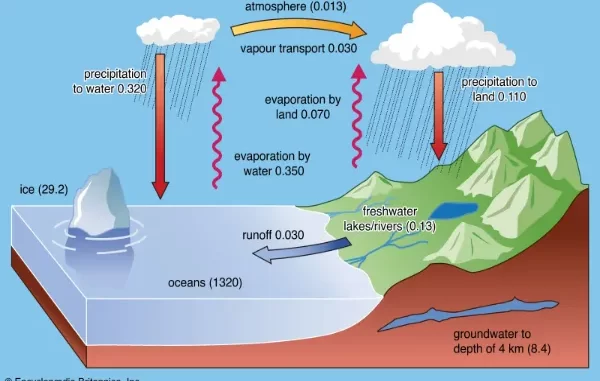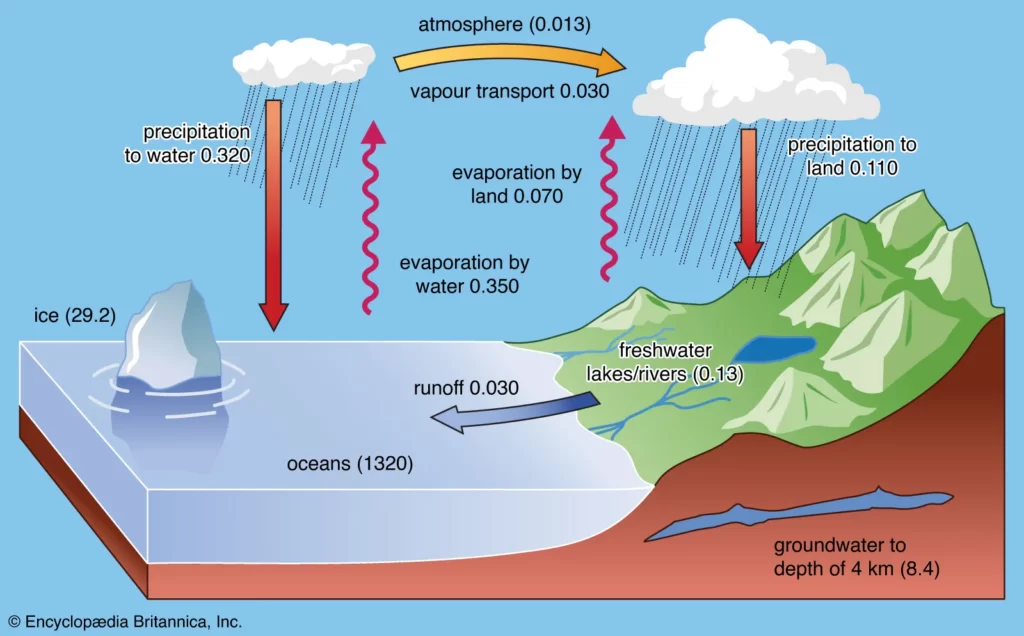
The Earth’s hydrosphere is a vast and complex system of water in all its forms, from liquid to solid and gas. It includes all the oceans, lakes, rivers, and streams on the surface of the Earth, as well as the groundwater that lies beneath the surface. It also includes the water vapor in the atmosphere. The hydrosphere is an incredibly important part of the Earth’s environment, and it is essential to life on the planet. Here are some interesting facts about the Earth’s hydrosphere. Read interesting facts about Earths Lithosphere on the link.
Fascinating Facts About the Earth’s Hydrosphere

The Earth’s hydrosphere is a vital resource that sustains life on our planet. It is composed of all the water on Earth, including oceans, lakes, rivers, and groundwater. Here are some fascinating facts about the Earth’s hydrosphere.
- The hydrosphere is composed of approximately 1.4 billion cubic kilometers of water. Of this, 97.5% is found in the oceans, 2% in glaciers and polar ice caps, and just 0.5% in lakes, rivers, and other sources.
- The water cycle is the process by which water evaporates from the oceans and other water bodies, rises into the atmosphere, forms clouds, and eventually falls back to the Earth as precipitation. This cycle is essential for maintaining the water balance on our planet.
- The average depth of the oceans is approximately 3,700 meters. The deepest point is located in the Mariana Trench, which reaches a depth of 11,000 meters.
- Water is the only substance found naturally on Earth in three forms: solid (ice), liquid (water), and gas (vapor).
- Water can dissolve more substances than any other liquid, which is why it is such an essential component of life.
- The largest river on Earth is the Amazon, which is over 6,400 kilometers long. It is also the most voluminous river on the planet, discharging an average of 209,000 cubic meters of water per second.
- The hydrosphere plays a major role in regulating the Earth’s climate. Water absorbs and retains heat energy, which helps to keep our planet from becoming too hot or too cold.
These facts demonstrate the critical role that the Earth’s hydrosphere plays in sustaining life on our planet. Its importance cannot be overstated.
Uncovering the Mysteries of the Earth’s Hydrosphere
The hydrosphere is a crucial part of our planet, and its mysteries are vast and varied. It covers about 71% of the Earth’s surface and contains 97% of all the water on the planet. This water is found in lakes, rivers, oceans, and even in the air we breathe. It is essential to life as we know it, and understanding the hydrosphere is essential for the health of our planet.
In order to understand the hydrosphere, it is necessary to explore the many components that make it up. These include both the solid and the liquid forms of water. In its solid form, water is found in glaciers, icecaps, snow, and hail. In its liquid form, water is found in lakes, rivers, streams, and oceans.
The hydrosphere is also home to many different types of organisms. These organisms range from microscopic bacteria and algae to large sea mammals such as whales and dolphins. These organisms play a vital role in the health of the hydrosphere by providing food and oxygen to other living things.
Water also plays an important role in the hydrologic cycle. This cycle involves the evaporation of water from the surface of the Earth, its condensation into clouds, and its eventual precipitation back on the surface. This cycle keeps the planet’s temperature balanced and helps to maintain the proper distribution of water on the planet.
The hydrosphere is also home to many different kinds of chemical processes. These processes occur when water interacts with other substances, such as minerals and organic compounds. These interactions can have a variety of effects, including the formation of sedimentary rocks, the formation of soils, and the formation of new minerals.
Finally, it is important to note that the hydrosphere is constantly changing. The water cycle is constantly in motion, and climate change is affecting the distribution and availability of water around the world. It is important to understand the role that the hydrosphere plays in our planet’s health so that we can take the necessary steps to protect it.
Exploring the Wonders of the Earth’s Hydrosphere
The hydrosphere is the collective term for the vast amounts of Earth’s water, including oceans, lakes, rivers, and groundwater. It is an integral part of the planet’s life-sustaining system. Without the hydrosphere, Earth would be a barren wasteland, uninhabitable by most forms of life.
The hydrosphere is made up of several distinct components. The ocean, which covers the majority of the Earth’s surface, is home to an incredible variety of marine life. The ocean also serves as a buffer zone, regulating the planet’s temperature and providing a vital source of food and energy.
In addition to the ocean, the hydrosphere includes rivers and streams, which are vital for transportation and irrigation. They are also essential for providing nutrient-rich sediment to replenish soil in agricultural areas. Lakes and reservoirs are important sources of clean drinking water, while groundwater supplies a significant portion of our freshwater needs.
The hydrosphere also acts as a repository for carbon dioxide, a major greenhouse gas. In the ocean, carbon dioxide is absorbed and stored in the form of dissolved carbon dioxide. This process helps regulate climate and prevents drastic temperature changes.
The hydrosphere is also a major source of renewable energy. Wave power, tidal power, and hydropower are all forms of energy that can be harnessed from the hydrosphere. This makes the hydrosphere an important part of a sustainable energy future.
The hydrosphere has been integral to human life for millennia. The abundance of life-supporting water it provides has allowed human civilization to thrive. As we look ahead to a future of climate change and dwindling resources, it is important to recognize the vital role the hydrosphere plays in sustaining life on Earth.
Leave a Reply